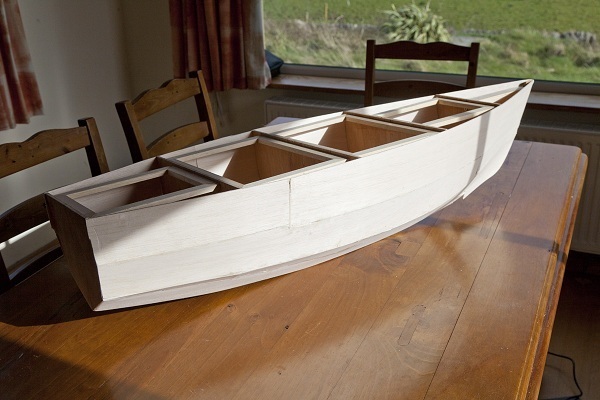Hull 001 is almost ready for fibreglass
by Dermot Tynan in Microtransat
Posted on Friday, May 03, 2013 at 08:00
After applying 3/32" balsa wood to the bulkheads and transom, the hull is starting to look like a real boat!
You can clearly see the deck support frames now. They are 6mm below the sheer line, to allow for 6mm exterior (or marine) ply deck pieces. But first, the balsa needs to be sanded and patched a bit. Also, the 3 or 4 layers of chopped strand matt need to be applied. When it is finished, the balsa wood will be completely enclosed in fibreglass. This is a standard "sandwich" construction. The balsa adds a layer of strength (believe it or not!) to the two layers of glass either side. It is similar to the central section of an I-beam or girder in that it separates the two outer layers and means that the bend radius is increased. Or at least, that's my understanding of it...
Now that the balsa is in place, the hull really does look like it is ready to go, and for the first time, I'm starting to think we might actually get down to the sea. On the minus side, now that the hull is visible in real life rather than a computer screen, I have to say that it is way too "beamy." The hull is close to 380cm on the beam which is too wide. It is also too deep, but I discussed that separately here: The hull starts to take shape..
The original plan was to build this hull as a half-scale model (it is 120cm LOA) and then double the numbers to make the "real" hull. However, I'm still unsure if I want to put 2.4 metres of fast fibreglass out to sea with a lot of other boats which might not see it. I'm particularly concerned about the boat surfing off a wave and T-boning a yacht in the middle of the Atlantic. Beoga Beag doesn't have eyes on deck. Container ships might hear a dull clink as the propellors grind up all my hard work, but sailing yachts tend to be quite thin around the gunwhales. So, the jury is still out. As our start date for the race isn't until October at the earliest, we have time to test this hull and decide. One temptation is to keep the height and width of the hull and extend the length by 2x. DelftSHIP will do that with a few clicks of a mouse. I'd probably have to re-fair some of the curves as the transom might not come up as high as it does in this 001 hull. I might also be tempted to add a sweeping sheer line rather than the straight one you see above. Either way, this hull will be perfectly adequate for what we need, which is a real hull in the water to begin working through the bugs.
Due to some other commitments we won't get much done for another week or so. But the next stage now is fibreglass.
I had intended to use 450g chopped strand matt, but given the sharp corners in places, I decided to go with a lighter 300g CSM. I will also finish off the outside layers with a layer of CSM tissue before I paint on the three or four layers of epoxy. On the inside, each of the compartments will be coated with 2 or 3 layers of CSM. The bulkheads will just be painted with epoxy. They don't need any glass strengthening. Overall, it shouldn't take too long before the hull is looking solid.
You'll notice the absence of a keel!
I'm still working through a few keel designs, and my original intention was to have interchangeable keels and rigs. The keel will have two threaded rods running down its centre, which will mount to a plate inside the hull in compartment #3. Before the boat goes to sea, the keel bolts and plate will be glassed in. Normally you would leave them exposed, but I'm not so sure...
Likewise, the carbon fibre mast will be interchangeable with the bendy mast of the final boat. The keel will probably follow a NACA 6312 shape and the rudder will conform to NACA 0012. The aspect ratio is looking like it will be 3 to 1, but it's early days yet.
Search
Upcoming Missions
- Galway Bay Loop, Waiting for Vessel Availability
Recent Posts
- May 2023 (1 post)
- April 2023 (1 post)
- March 2023 (1 post)
- February 2023 (2 posts)
- March 2022 (3 posts)
- March 2021 (1 post)
- August 2020 (1 post)
- May 2019 (1 post)
- April 2018 (1 post)
- November 2017 (1 post)
- April 2017 (1 post)
- November 2016 (1 post)
- September 2016 (1 post)
- August 2016 (1 post)
- January 2014 (2 posts)
- October 2013 (7 posts)
- September 2013 (1 post)
- August 2013 (3 posts)
- June 2013 (3 posts)
- May 2013 (4 posts)
- April 2013 (3 posts)
- March 2013 (9 posts)
- February 2013 (8 posts)
